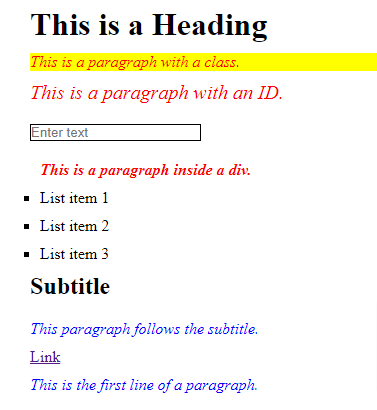CSS Selectors
<!DOCTYPE html>
<html lang="en">
<head>
<title>CSS Selectors</title>
<style>
/* Element Selector */
p {
color: red;
}
/* Class Selector */
.my-class {
background-color: yellow;
}
/* ID Selector */
#my-id {
font-size: 20px;
}
/* Attribute Selector */
[type="text"] {
border: 1px solid black;
}
/* Universal Selector */
* {
margin: 10px;
padding: 0;
}
/* Descendant Selector */
div p {
font-weight: bold;
}
/* Child Selector */
ul > li {
list-style-type: square;
}
/* Adjacent Sibling Selector */
h2 + p {
margin-top: 20px;
}
/* General Sibling Selector */
h2 ~ p {
color: blue;
}
/* Pseudo-class */
a:hover {
text-decoration: underline;
}
/* Pseudo-element */
p::first-line {
font-style: italic;
}
</style>
</head>
<body>
<h1>This is a Heading</h1>
<p class="my-class">This is a paragraph with a class.</p>
<p id="my-id">This is a paragraph with an ID.</p>
<input type="text" placeholder="Enter text">
<div>
<p>This is a paragraph inside a div.</p>
</div>
<ul>
<li>List item 1</li>
<li>List item 2</li>
<li>List item 3</li>
</ul>
<h2>Subtitle</h2>
<p>This paragraph follows the subtitle.</p>
<a href="#">Link</a>
<p>This is the first line of a paragraph.</p>
</body>
</html> Code Output

CSS Selectors
There are several types of selectors in CSS:
-
- Element Selector: Selects elements based on their HTML tag name. For example,
pselects all<p>elements. - Class Selector: Selects elements based on their class attribute value. For example,
.my-classselects all elements withclass="my-class". - ID Selector: Selects an element based on its unique ID attribute value. For example,
#my-idselects the element withid="my-id". - Attribute Selector: Selects elements based on their attribute values. For example,
[type="text"]selects all elements withtype="text". - Universal Selector: Selects all elements on the page. It is represented by an asterisk (
*). - Descendant Selector: Selects elements that are descendants of another element. For example,
div pselects all<p>elements that are descendants of<div>elements. - Child Selector: Selects elements that are direct children of another element. For example,
ul > liselects all<li>elements that are direct children of<ul>elements. - Adjacent Sibling Selector: Selects an element that immediately follows another element. For example,
h2 + pselects the<p>the element that directly follows an<h2>element. - General Sibling Selector: Selects elements that are siblings of another element. For example,
h2 ~ pselects all<p>elements that are siblings of<h2>elements. - Pseudo-classes: Selects elements based on a specific state or condition. For example,
a:hoverselects<a>elements when hovered over by the mouse. - Pseudo-elements: Selects and styles specific parts of an element. For example,
p::first-lineselects the first line of<p>elements.
- Element Selector: Selects elements based on their HTML tag name. For example,